Apply now to join our next cohort of Community Science Fellows and Community Leads!
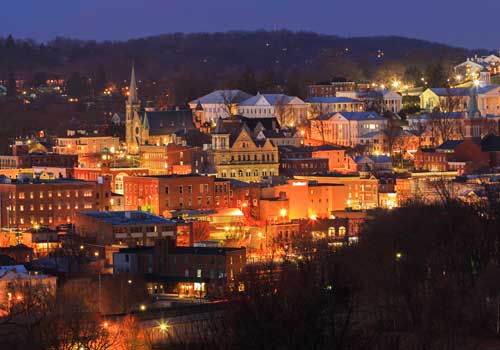
Project Title: Establishing a Plastic Waste Management Program
Location: Staunton, VA
The Team:
Shenandoah Green wants to increase awareness about the importance of waste stream management throughout the complete flow of waste management from domestic or industrial areas to final disposal. A major community priority is to understand the leakage of waste into the environment due to poor management practices with a specific interest in impacts of single-use plastics on soil, water, and air quality is, as well as the associated human health impacts.
The Staunton, VA project was a remote collaboration between community leaders in Virginia and a scientist across the country in California. Most of their engagement was via telephone and email, but the bulk of the project work was completed during a week-long visit by Win to Staunton in September 2019 featuring 16 meetings, field sampling, and a tour of the best of Staunton’s hospitality.
The field method resources developed through this project are linked below under “Outputs and Impact.”
Meetings, Seminars, and Trainings
Shenandoah Green is an especially connective organization in the community. A priority for their week long visit was to provide Win the opportunity to meet, educate, and train their collaborators and influencers. The team’s Sunday – Friday engagements included meetings with representatives of:
Some highlights included visiting sources of local plastic pollution, learning about the local lifecycle of plastic, and discussing microplastics and community concerns with local residents. The team consistently found that those they were speaking with were excited about this work and eager to ask (Win, in particular) questions. The team is now better positioned to engage with local environmental players on plastic pollution issues, and engage them in future data collection efforts.
Sampling for Microplastics in Water
During their time together, the team conducted sampling of local waterways for microplastics in partnership with over 20 local volunteers. They did this sampling using research trawls brought in by Win from his lab, as well as a DIY home sampling kit, BabyLegs, developed by PublicLab. They rigorously compared the sampling efficiency of BabyLegs to the research grade trawl to maximize the utility of the BabyLegs trawl which will stay with Shenandoah Green. BabyLegs performed well under most of the flow conditions the team encountered, but a larger opening will be developed in the future to decrease the sampling time required when using BabyLegs.
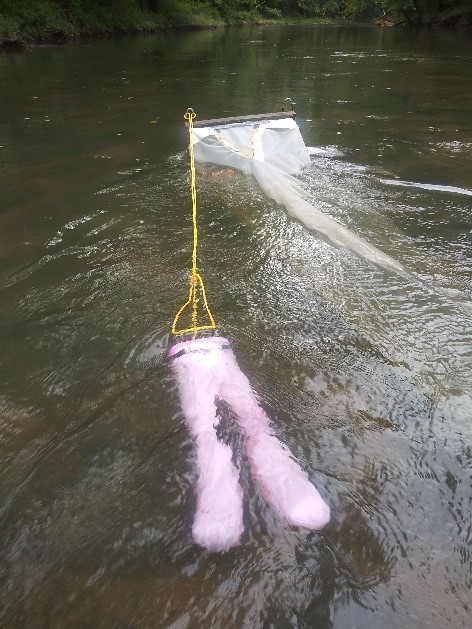
BabyLegs deployed alongside a research trawl
After 5 days of stream sampling at 6 different locations throughout the Shenandoah Valley, they found 1 piece of microplastic. This was equivalent to <1 piece of microplastic per 100 cubic meters of water. Win characterized this as well below the threshold for concern using recent plastic pollution risk assessment literature. Although no plastic is ideal.
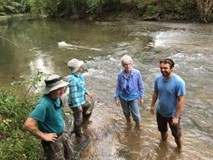
These results allow the team to assess the health of local waterways in respect to the degree of plastic pollution. Other things were also caught in the net like leaves and insects which could be studied in future efforts to increase the knowledge that can be gained from a single sample and aid local ecology researchers. Future microplastic sampling with nets should leave the sampling device in the water to collect larger samples (> 1000 cubic meters) so that the concentrations can be accurately measured.
Sampling for Microplastics in Sediment
The team found a few locations where deposits of microplastic in sediment exist near the landfill. A future study could survey sediment throughout the streams to identify high impacted locations to monitor.
Sampling for Microplastics in Biota
A concern of Shenandoah Green is that organisms may be ingesting plastic even in though there are low concentrations of microplastics present in the streams. Future studies could also assess the impact to organisms by dissecting them and searching their gut contents for plastic.
Surveying Plastic Pollution on Land
The team surveyed Staunton streets for trash using Google Street View. 1,000 randomly distributed images were surveyed, 4/100 of which were found to contain trash. There were no clear hotspots, suggesting that trash is equally distributed throughout the city.
[ezcol_2third]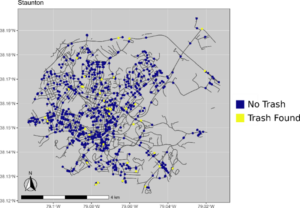 [/ezcol_2third] [ezcol_1third_end]
[/ezcol_2third] [ezcol_1third_end] [/ezcol_1third_end]
[/ezcol_1third_end]
Trash Data Analytics Tool
Prior to the visit, Win developed an online tool in consultation with Fred and Georgi to quickly analyze clean-up data for trash type and volume. This data can be used to prioritize reduction efforts through local policy and management practices. More data on trash is needed and can be collected by reaching out to people already doing cleanups and inviting them to contribute. Current results show cigarette butts and plastic pieces to be the most prevalent pieces of trash in the environment.

This project created a system of procedures and tools supporting Shenandoah Green efforts (alongside community members and other allied organizations) to document and share about the types and quantity of trash and plastic pollution in the local environment. It also fed into a larger effort by Shenandoah Green to muster community engagement on local trash and recycling priorities, and strengthen linkages between and among area nonprofit groups.
Specific outputs produced through the project include:
This collaboration also contributed to the planning and implementation of a comprehensive and strategic effort to form partnerships with key groups and individuals in and around the community. Each meeting and conversation resulted in something useful and impactful for Shenandoah Green. There were also ripple effects: influential individuals were inspired to participate in the local climate strike because of the impression the team made on them, and the Lewis Creek Watershed Committee is revisiting its charter based on conversations with the project team.
Things that contributed to the team’s success included:
Things that the team would do differently if they could start over include:
Advice the team has for future projects:
Although this Thriving Earth Exchange project is complete, Shenandoah Green is incorporating the outputs into larger community engagement work moving forward. Coming out of the project, they are equipped to train volunteers in the use of these custom procedures and tools, and can readily apply them for collecting and analyzing data from trash cleanups.
Fred and Georgi are also in the process of acquiring and deploying equipment to further monitor stream and sediment health, including sustaining collaboration with local labs to provide better understanding of impacts to the local environment from plastic pollution.
Other efforts underway, include but are not limited to:
Follow their incredible efforts at ShenandoahGreen.org.

L-R: Win, Georgi, Fred
The City of Staunton, VA and the surrounding community located in Augusta County plan to increase awareness about the importance of waste stream management, the complete flow of waste from domestic or industrial areas to final disposal. The responsiveness to environmental impacts of single-use plastics on soil, water, and air quality is a major community priority, as well as the associated human health impacts. Community leaders, including the local Earth Day committee, have outlined 4 priorities:
The City of Staunton, VA and the surrounding community located in Augusta County are the focus of this project description. Downtown Staunton is home to Mary Baldwin University. Staunton is also close to the University of Virginia, James Madison University, Washington & Lee University and Virginia Military Institute.
Staunton is consistently on many “top 20 small town” lists for culture, arts, architecture and preservation by such organizations as Smithsonian, Architectural Digest, Southern Living and several travel sites. It is a town noted for its beauty and its nationally recognized main street. Along with these recognition, the TEX community leaders would like to see Staunton appear on top lists of towns that are environmentally progressive and that practice sustainable lifestyles.
These project updates come straight from the communities and scientists we work with. Send your Thriving Earth liaison a quick update + photo and we’ll highlight your project in our next newsletter!
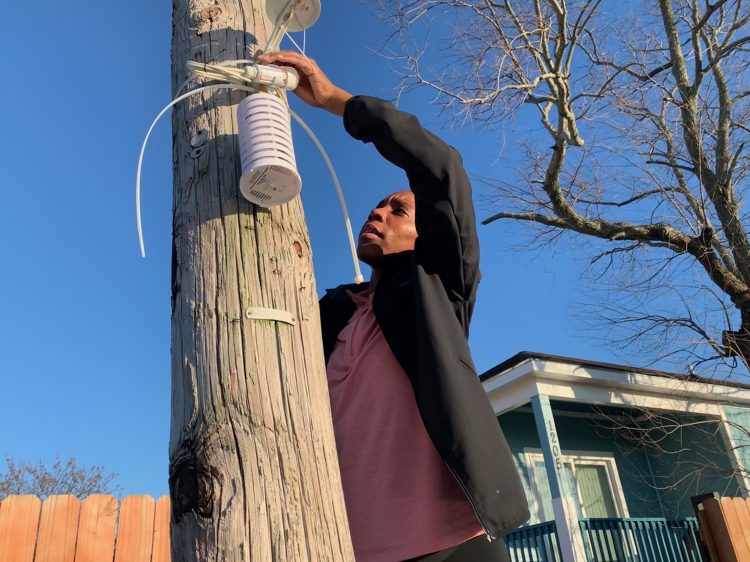
Yasmin Davis installing weather sensors
From 7th Ward, New Orleans: Raising Sensors, money, and trees in the 7th Ward: Yasmin Davis (pictured) and Kayla Frand installed sensors to capture local weather features with ISeeChange. The team was awarded a $3,825 grant from the Tulane Center for Public Service for community meetings, student assistance and more sensors. Images of photoshopped tree plantings were created to gather community opinions in the 7th Ward under community leader Angela Chalk in collaboration with Thriving Earth Exchange, Tulane, Georgia Tech and the EPA.
From Durango, Co.: During 2018 and early-2019, the City of Durango Sustainability Coordinator, Imogen Ainsworth, worked with local scientists, Laurie Williams and Joanna Gordon Casey to conduct a Community-wide Greenhouse Gas Emissions Inventory for the area inside Durango City Limits.
In March 2019, after much collaboration, learning and some challenges, Imogen presented draft data to Durango City Council. With the exception of the on-road transportation data, the figures presented are likely to be those that appear in the final report. The draft inventory reveals energy use by commercial buildings and facilities to be the greatest source of emissions, followed by transportation and residential energy.
Imogen is currently working to complete a draft report of the inventory, highlighting results along with actions underway to reduce emissions, and possible future actions. The report will be reviewed first by City staff along with Laurie and Joanna, before being shared with other community members and, finally, published on the City’s website and shared with the public.
Per the City’s Sustainability Action Plan, the inventory will be updated every three years, with the next update due in 2020 using 2019 data. Once the inventory report is finalized, the team will work to document methodology and identify opportunities for improvements in data collection and reporting processes.
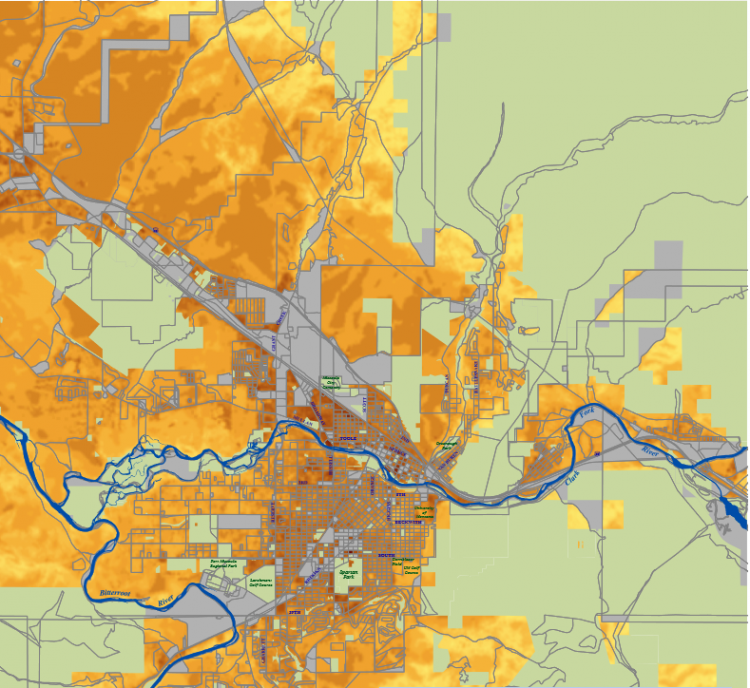
Vulnerability to temperature map created by Julia Tomkins M.S. Montana University
From Missoula, Mont.: Student research shows that increasing heat and wildfires will place Missoula’s disabled at risk. Climate Smart Missoula and the City of Missoula Climate Office initiated this project with Thriving Earth Exchange to study the effects of heat in the Missoula urban environment. The heat vulnerability map overlaid socioeconomic factors with heat exposure for the city of Missoula at the unprecedented census block scale. The primary components of vulnerability are linked strongly to communities with disabilities, living alone or low income. These findings will be presented to the city of Missoula committees and full Council, and the team plans to present the findings present at a Downtown Missoula Master Plan session and an Invest Health meeting.
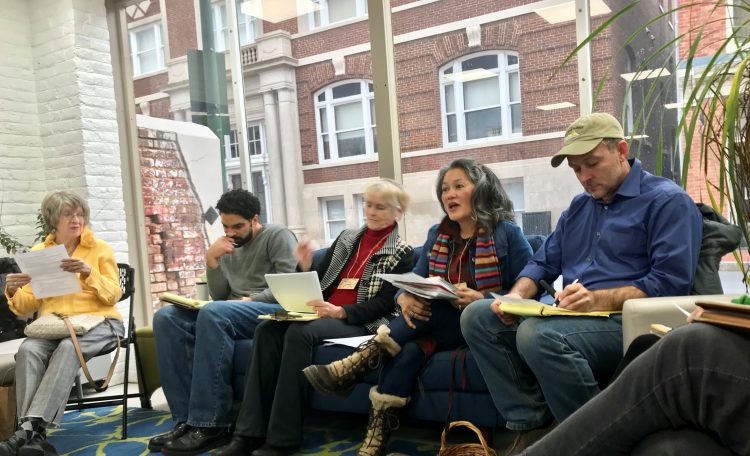
BJ Vaughn representing Staunton Downtown Development Association, Melody Tennant, Chair of Shenandoah Green, Georgi Tomisato, Founder-President of Shenandoah Green and Tim Kreps representing Sustainable Shenandoah Valley.
From Staunton, Va.: Collaboration is key! This project’s goal is to eliminate single-use plastic straws and shopping bags, map and cut back Staunton’s waste flow, measure plastic in the Middle River and tributaries (all of which are part of the Chesapeake Bay watershed) and educate the public on the hazards of plastics. In January, the two project community leaders joined forces with others in the community who were interested in the fight against plastic and formed a group called Shenandoah Green. Shenandoah Green had its first meeting of multiple community groups and the local mayor, Carolyn Dull, on February 01, 2019 to discuss resources and the collaboration necessary to develop a sustainable conservation initiative in the Shenandoah Valley.
 Georgi Tomisato of EarthDay Staunton is a farm owner in Augusta county and active member of the City of Staunton. She is a former educator, practicing farmer and community activist.
Georgi Tomisato of EarthDay Staunton is a farm owner in Augusta county and active member of the City of Staunton. She is a former educator, practicing farmer and community activist.

Fred Blanton, an involved resident of the City of Staunton, is an analyst with Boeing and a Sister Cities International Representative.
Georgi and Fred are founding members of Shenandoah Green, a non-partisan, grass-roots organization, working with local and scientific stakeholders to create an environmentally sustainable community through education and advocacy.
Win Cowger, University of California, Riverside (Photo and biography coming soon!)
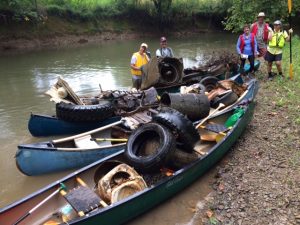
RiverPickers Carol, David, Joe, Mark, Marion
The Friends of the Middle River (FOMR) was started in 2010 by a group of citizens who had been influenced and inspired by a conference in 2009, sponsored by the Virginia Department of Environmental Quality (DEQ). The organizers of FOMR felt that the community of residents who were interested in the welfare of the Middle River needed a collective voice. Since 2010, FOMR has sponsored activities to heighten awareness of the Middle River’s recreation opportunities as well as its water quality challenges.
Our mission: FOMR promotes the stewardship and enjoyment of the Middle River Watershed through volunteer action, education, science, and outreach.
(c) 2025 Thriving Earth Exchange